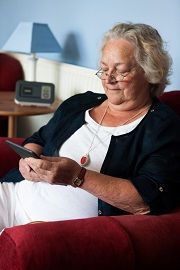Zillah Moore, director at Tunstall Healthcare, discusses why technology should be integrated into buildings from the design and construction stage, and why there is a need for builders and architects to collaborate more effectively with health and social care providers
Thanks to the innovations that have been rapidly taking place during the COVID-19 pandemic, our health and social care systems have been revolutionised and our population is becoming more empowered to manage its own health and wellbeing.
And this is particularly evident in areas where technology is being deployed effectively and at pace.
A better application of technology in new builds will reduce the strain on staff and carers and provide managers with greater insight into how best to allocate resources, leading to more-pro-active and predictive care
Whether it’s a state-of-the-art care home, or a development of assisted living facilities, a holistic approach to care which integrates technology is required if we are to become global leaders in health and wellbeing provision.
However, this is reliant upon architects, engineers, and builders working closely with health and social care providers to ensure systems are wired into the fabric of buildings to meet the needs and expectations of a 21st-century, post-pandemic population.
The benefits of technology
Technology-enabled care solutions (TECS) maximise user independence and safety, making them a crucial consideration at the architectural planning stage.
These systems offer numerous benefits, from automatic detection of events such as falls; to remote health monitoring which reduces the need for face-to-face health appointments, and therefore cross-infection.
As well as improving quality of life and health outcomes, this can also reduce the pressure on primary and secondary care, resulting in associated cost savings.
A better application of technology in new builds will reduce the strain on staff and carers and provide managers with greater insight into how best to allocate resources, leading to more-pro-active and predictive care.
Greater integration of technology not only mitigates the various impacts experienced during the pandemic, but supports the reshaping of health and social care services for the future
Greater integration of technology not only mitigates the various impacts experienced during the pandemic, but supports the reshaping of health and social care services for the future.
Case study

Zillah Moore
Northampton Partnership Homes (NPH) and construction firm, Jeakins Weir, recently worked together to integrate smart technology into a new innovative housing development comprising eight semi-detached bungalows that will support the independence of young adults with learning disabilities and complex needs.
Smart technology was integrated at the planning stage of the development to provide more-person-centred support, as well as offering greater insight into how best to allocate resources to meet the needs of the people living there.
The system supports the use of telecare sensors and wearable technology, such as fall detectors, which will automatically raise an alert if help is required, enabling care to be given where and when it is needed, but supporting independence when it isn’t.
Combating COVID

Moore argues that integration of technology needs to be considered at the earliest stage of construction projects
Technological and digital solutions have played a significant role in combating the various effects of the pandemic. However, if integration into new builds before COVID-19 had been commonplace, our health and care services would have been better equipped to cope with the ongoing pressures.
When assistive technology is deployed in locations where vulnerable people are present, it enables key stakeholders to view data from multiple sources and adapt care delivery according to an individual’s needs.
Intelligent systems can provide both predictive and preventative measures when assessing risks and mitigating circumstances, to improve and sustain desirable health outcomes.
We can use technology to empower individuals, families, and carers, and ensure people have the right level of care and support to age in place safely and reduce the impacts of future health crises.
Putting it into practice
Park View Care Home in Halifax had innovative wireless technology installed prior to the pandemic, which allowed it to avoid a single case of COVID-19.
The new nurse call system enabled care to be delivered in exclusive bubbles thanks to its revolutionary alert system where staff were split into three teams and allocated to care for specific residents, reducing the risk of cross infection and enabling residents to be cared for while isolating if required.
During the pandemic, the technology supported 10 staff members to move into the home full time and isolate to ensure round-the-clock monitoring of residents, alongside different areas of the building being sectioned off while still delivering a normal level of care.
Looking ahead
A longer-term approach is needed in order to meet the changing demands of modern care delivery in a post-pandemic world.
The integration of technology at the planning and construction stage of new builds, and the effective collaboration between builders, architects, and health and social care providers is crucial if we are to build back better after COVID-19 and safeguard our services for the future
The last decade has seen an exponential increase in the adoption of technology across everyday life, with smart speakers, heating, and lighting systems now commonplace.
However, the potential of technology to support vulnerable people still has a way to go due to fragmented care structures, limited resources, and reluctance to change.
The integration of technology at the planning and construction stage of new builds, and the effective collaboration between builders, architects, and health and social care providers is crucial if we are to build back better after COVID-19 and safeguard our services for the future.




